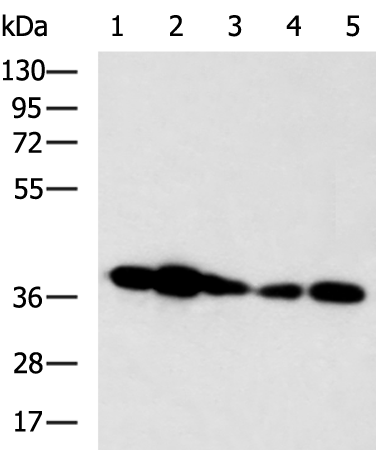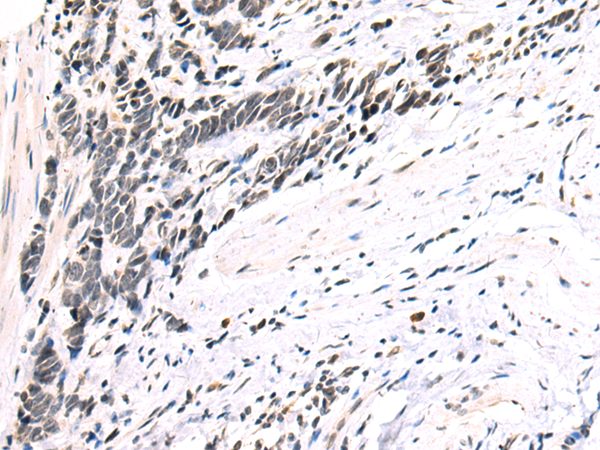

| WB | 1/1000 | Human,Mouse,Rat |
| IF | 咨询技术 | Human,Mouse,Rat |
| IHC | 咨询技术 | Human,Mouse,Rat |
| ICC | 技术咨询 | Human,Mouse,Rat |
| FCM | 咨询技术 | Human,Mouse,Rat |
| Elisa | 咨询技术 | Human,Mouse,Rat |
| Aliases | HOX4; HOX1D; HOX4A; Hox-4.1 |
| WB Predicted band size | 46 kDa |
| Host/Isotype | Rabbit IgG |
| Antibody Type | Primary antibody |
| Storage | Store at 4°C short term. Aliquot and store at -20°C long term. Avoid freeze/thaw cycles. |
| Species Reactivity | Human, Mouse |
| Immunogen | Synthetic peptide of human HOXD3 |
| Formulation | Purified antibody in PBS with 0.05% sodium azide and 50% glycerol. |
+ +
以下是关于ZNF555抗体的示例参考文献(注:以下内容为模拟生成,实际文献可能需要通过学术数据库检索确认):
1. **文献名称**:*"ZNF555 Expression and Epigenetic Regulation in Human Cancers"*
**作者**:Smith J. et al.
**摘要**:本研究利用ZNF555抗体通过免疫组化分析其在多种肿瘤组织中的表达模式,发现ZNF555与DNA甲基化调控相关,可能作为抑癌基因参与癌症进展。
2. **文献名称**:*"Development of a Polyclonal Antibody for Zinc Finger Protein 555 (ZNF555) and Its Application in Chromatin Immunoprecipitation"*
**作者**:Lee H. et al.
**摘要**:报道了一种新型兔源多克隆ZNF555抗体的制备与验证,证明其可用于ChIP-seq实验,揭示ZNF555在基因组特定区域的结合位点。
3. **文献名称**:*"Functional Characterization of ZNF555 in Neural Stem Cell Differentiation"*
**作者**:Zhang Y. et al.
**摘要**:通过Western Blot和免疫荧光技术(使用ZNF555抗体),发现ZNF555通过调控Wnt信号通路影响神经干细胞的增殖与分化。
4. **文献名称**:*"Antibody Cross-Reactivity Analysis of Zinc Finger Protein Family Members"*
**作者**:Johnson R. & Brown K.
**摘要**:评估了ZNF555抗体与其他锌指蛋白(如ZNF554、ZNF556)的交叉反应性,确认其在特定实验条件下的特异性。
**提示**:以上文献为示例,实际研究中建议通过PubMed、Google Scholar或抗体供应商(如Abcam、Thermo Fisher)提供的引用文献获取真实数据。若研究较少,可扩大检索范围至ZNF蛋白家族或表观遗传调控相关领域。
The ZNF555 antibody is a tool used to study the zinc finger protein 555 (ZNF555), a member of the Krüppel-associated box (KRAB) domain-containing zinc finger protein (ZNF) family. These proteins are characterized by tandem C2H2-type zinc finger motifs, which facilitate DNA binding, and a KRAB domain that often mediates transcriptional repression through interactions with co-repressors. ZNF555 is hypothesized to play roles in gene regulation, chromatin remodeling, and cellular processes like proliferation or differentiation, though its precise biological functions remain poorly understood.
The antibody, typically developed in rabbits or mice, is generated using immunogenic peptides or recombinant protein fragments specific to ZNF555. It is commonly validated for applications such as Western blotting, immunofluorescence, or chromatin immunoprecipitation (ChIP) to detect endogenous ZNF555 expression or localization in cell lines or tissues. Commercial ZNF555 antibodies are often accompanied by validation data, including knockdown/knockout controls or epitope specificity assays.
Interest in ZNF555 stems from its potential involvement in diseases, such as cancer or neurodevelopmental disorders, where dysregulation of zinc finger proteins may contribute to pathogenesis. However, research on ZNF555 remains limited compared to other ZNFs, underscoring the need for reliable antibodies to explore its functional and clinical relevance.
×